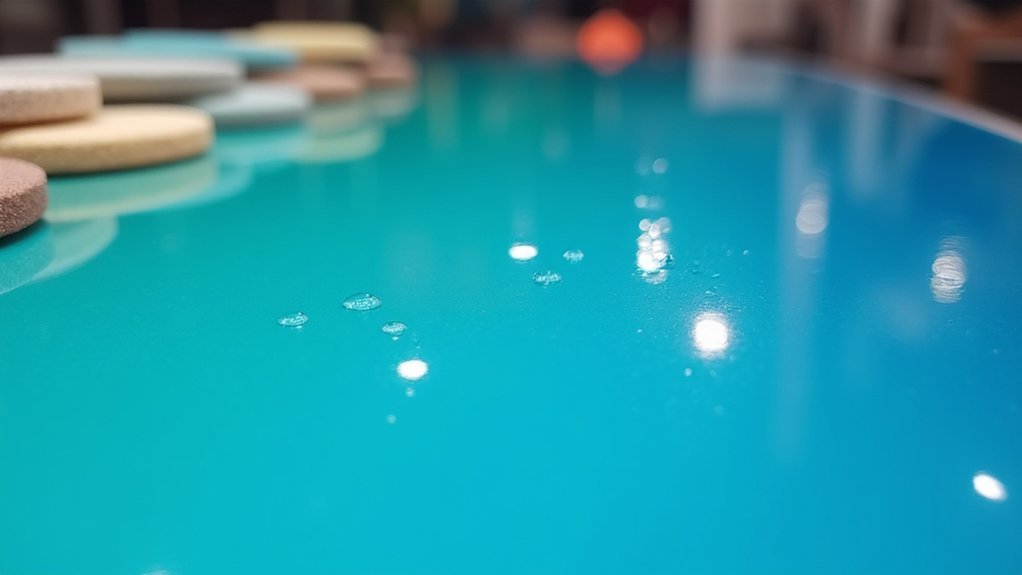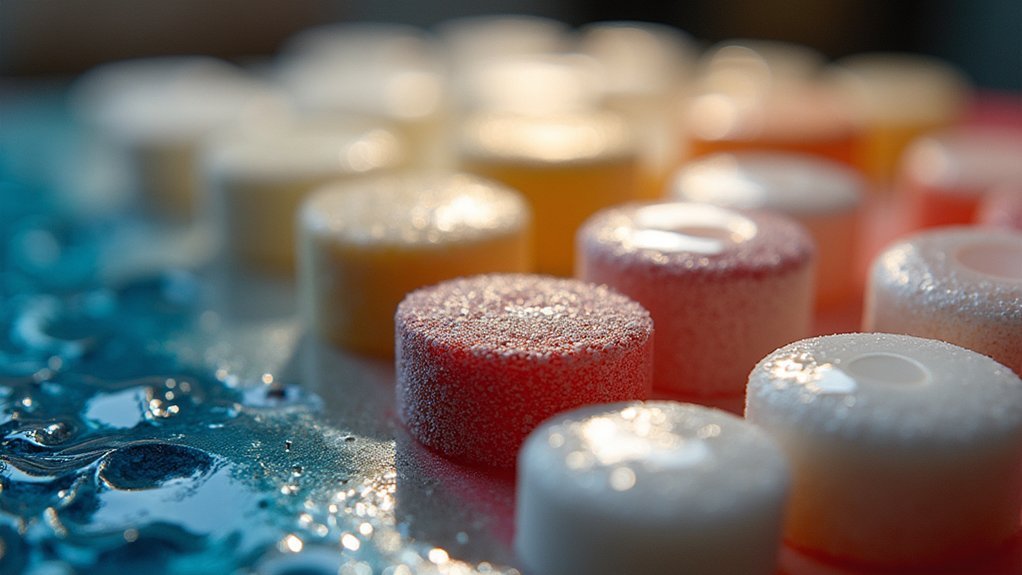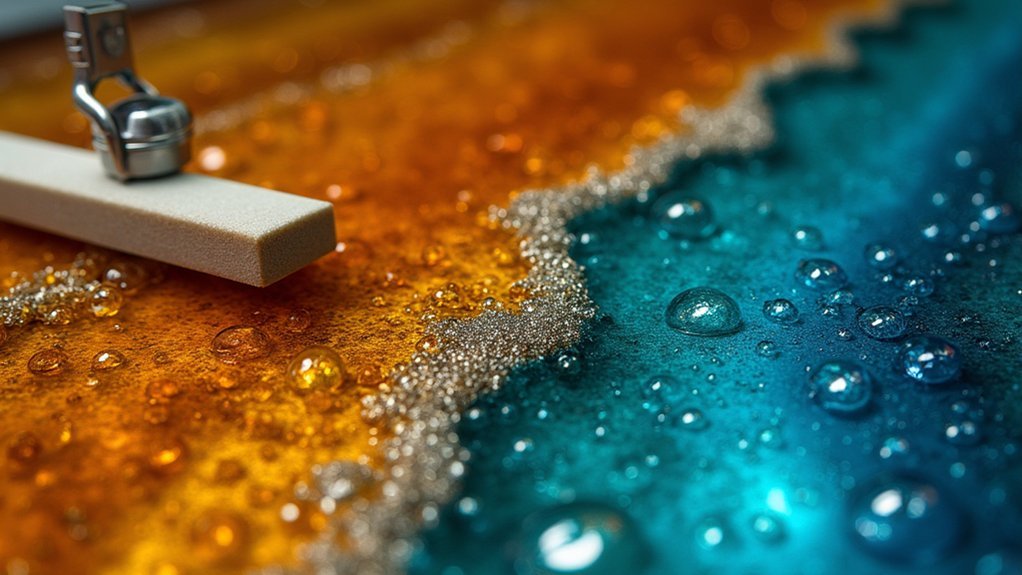You’ll achieve stunning resin finishes through five proven methods: progressive wet sanding from 400 to 3000 grit with consistent water application, high-gloss lacquer over sanding sealer in thin coats, professional polishing compounds using a systematic 6-step process, UV-resistant methacrylate coating applied in dust-free environments, and multi-stage buffing with cotton wheels and fine abrasives. Each technique requires proper surface preparation, consistent pressure, and patience between applications. Master these approaches to transform any dull surface into crystal-clear perfection with professional-grade results.
Progressive Wet Sanding Technique for Mirror-Like Results

When you’re aiming for a mirror-like finish on resin, progressive wet sanding becomes your most reliable technique.
Start with 400-grit sandpaper and work systematically through finer grits up to 2000 or 3000. Apply water consistently to reduce friction and prevent overheating that damages resin.
Begin with 400-grit sandpaper, progressing methodically through increasingly finer grits to 2000-3000 while maintaining consistent water application to prevent resin damage.
Rinse thoroughly between each grit to avoid cross-contamination, which creates cloudiness. Maintain consistent pressure throughout—even light, steady pressure yields better results than aggressive sanding.
Once you’ve achieved a uniformly dull surface with your finest grit, shift to polishing compounds.
Use a soft cloth or polishing pad in circular motions to develop that coveted high gloss finish. This methodical approach transforms rough resin into a flawless, mirror-like surface that reflects light beautifully.
High-Gloss Lacquer and Sanding Sealer Application Method
For resin projects requiring maximum durability and brilliance, high-gloss lacquer paired with sanding sealer delivers professional-grade results that surpass other finishing methods.
Start by applying a high solids sanding sealer to create a smooth base that enhances adhesion and durability. Sand the surface with progressively finer grits from 400 to 3000 grit, ensuring you’ve prepared the perfect foundation for your flawless finish.
Apply multiple thin coats of high-gloss lacquer, allowing adequate drying time between applications to prevent clogging and achieve uniform shine.
Maintain a dust-free environment throughout the process to avoid imperfections.
Finally, buff the final layer with a cotton buffing pad to enhance the gloss and achieve that professional, high-lustre appearance you’re seeking.
Professional Polishing Compound System With Magic Juice

While high-gloss lacquer provides excellent results, the Magic Juice polishing compound system offers an alternative approach that achieves the same professional-grade finish through a systematic 6-step process.
You’ll start with coarse polishing compounds and progressively move to finer grits, effectively removing scratches and imperfections from your resin surface.
Each application requires proper drying time to prevent clogging and guarantee superior results.
You’ll want to use soft polishing pads or microfiber cloths for best application and buffing outcomes.
The specialized polishing compounds are formulated specifically for resin materials, delivering exceptional high shine performance.
This methodical approach culminates in a durable, glass-like shine that enhances your piece’s aesthetic and clarity with professional-grade results.
UV-Resistant Methacrylate Resin Coating Process
UV protection becomes paramount when your resin projects face prolonged sun exposure, making methacrylate resin coating an essential finishing technique.
Begin with thorough surface preparation – the sanding process removes imperfections and creates ideal adhesion for your coating.
Work exclusively in dust-free environments to prevent contamination during application. Follow manufacturer’s mix ratios precisely, as proper curing requires specific formulations.
Apply multiple coats in thin layers rather than single thick applications. Allow each layer to cure completely under both ambient conditions and UV light exposure before proceeding.
This methodical approach builds up your desired gloss finish gradually while maximizing durability.
The UV-resistant properties protect underlying materials from degradation, while the methacrylate’s enhanced clarity maintains visual appeal.
Each successive coat increases both protection and shine, delivering professional-grade results for outdoor applications.
Multi-Stage Buffing With Cotton Wheels and Fine Abrasives

After applying your protective coating, achieving that mirror-like finish requires a systematic buffing approach using cotton wheels and progressively finer abrasives.
Multi-stage buffing transforms ordinary resin surfaces into glass-like masterpieces through careful progression from coarse to fine compounds.
Multi-stage buffing elevates resin from ordinary to extraordinary, creating mirror-perfect surfaces through methodical progression of increasingly refined polishing compounds.
Start with 2000-grit polishing compounds, then advance to 3000-grit and beyond for ideal results. Cotton wheels distribute these fine abrasives evenly while preventing surface scratches that could compromise your finish.
- Apply light, consistent pressure to prevent heat buildup and cloudiness
- Begin with medium-grit compounds before progressing to ultra-fine grades
- Clean cotton wheels between stages to avoid cross-contamination
- Work systematically across the surface for uniform shine distribution
Frequently Asked Questions
How to Get a Shiny Finish on Resin?
You’ll achieve a shiny resin finish by wet sanding from 400 to 3000 grit, applying quality polishing compound with soft cloth, then finishing with protective sealant for lasting gloss.
How to Get Shine in Resin Art?
You’ll achieve brilliant shine by wet sanding from 400 to 3000 grit, then buffing with resin polishing compound in circular motions. Finish with UV-resistant clear coat to protect and enhance the glossy surface.
How Do You Make Resin Art Glossy?
You’ll achieve glossy resin art by sanding with progressively finer grits from 400 to 2000, then applying polishing compound with circular motions, and finishing with a clear topcoat or gloss sealer.
How to Make Resin Shine Like Glass?
You’ll achieve glass-like shine by wet sanding from 400 to 2000 grit, applying automotive polishing compound in circles, then buffing with microfiber cloth using even pressure for consistent results.
In Summary
You’ve now got five proven methods to achieve that perfect resin finish you’re after. Whether you choose wet sanding, lacquer application, polishing compounds, UV-resistant coating, or multi-stage buffing, you’ll get professional results. Don’t rush the process—each technique requires patience and attention to detail. Pick the method that best suits your project’s needs and your skill level. With practice, you’ll consistently produce stunning, mirror-like finishes that’ll impress anyone.





Leave a Reply